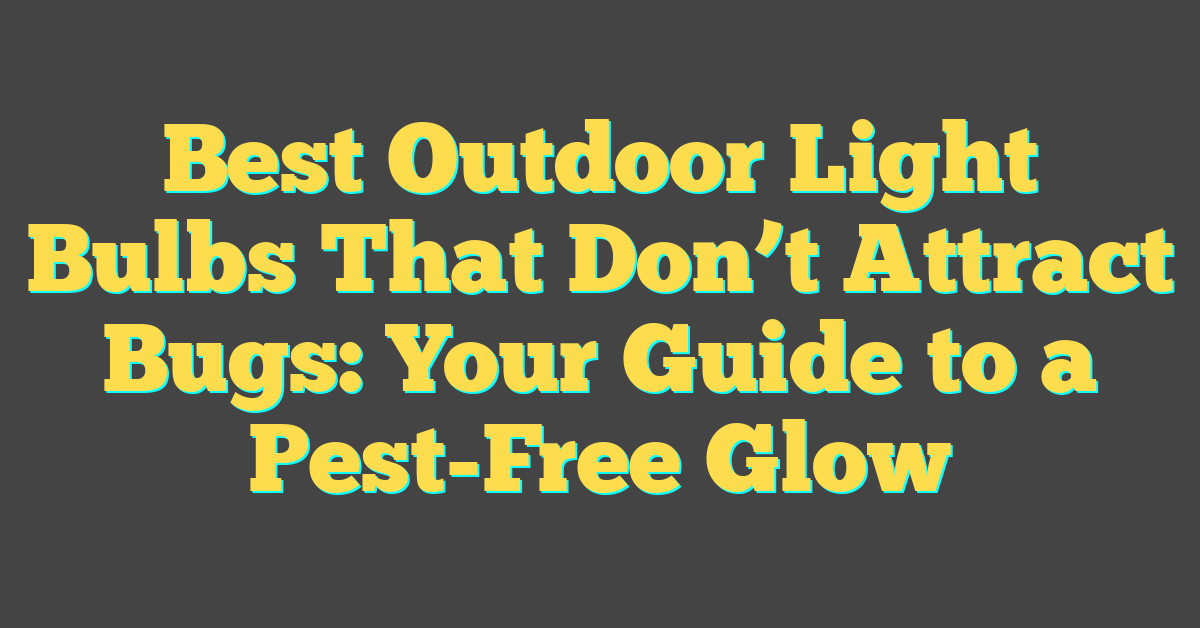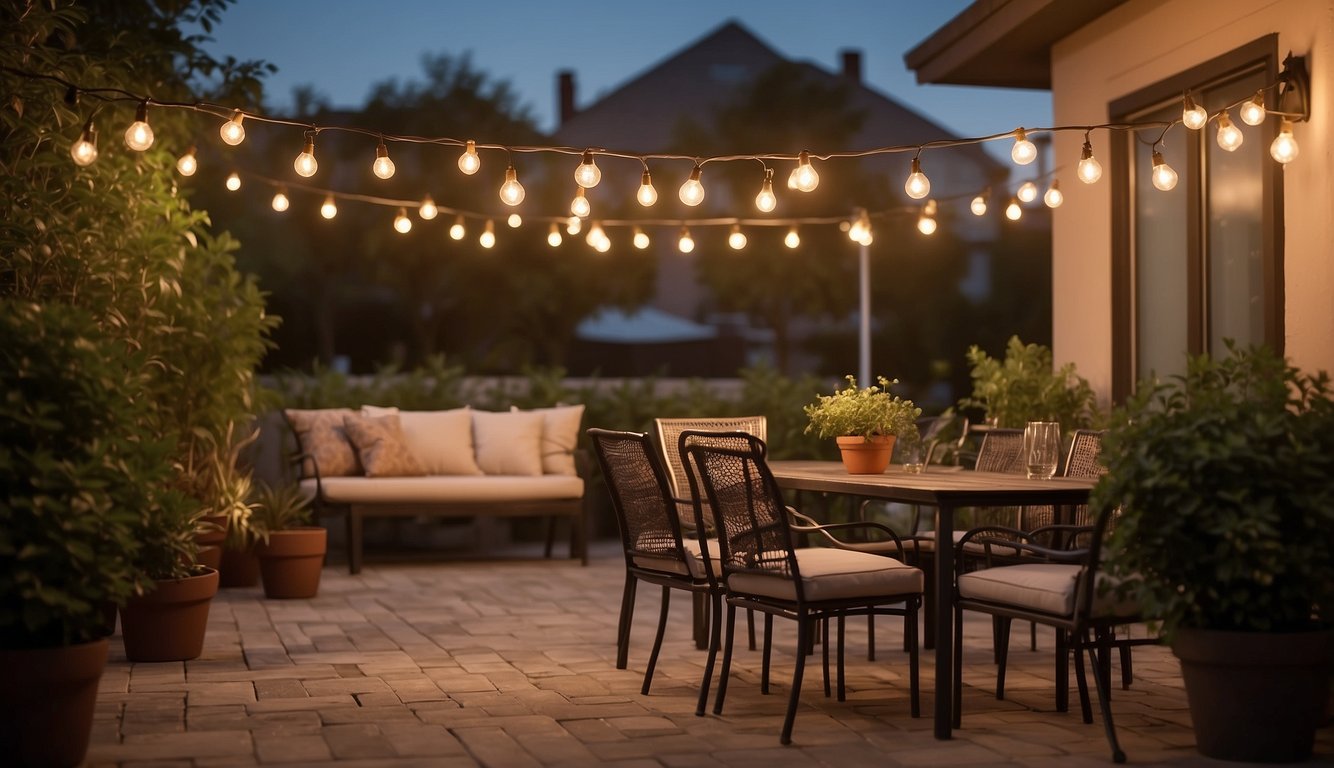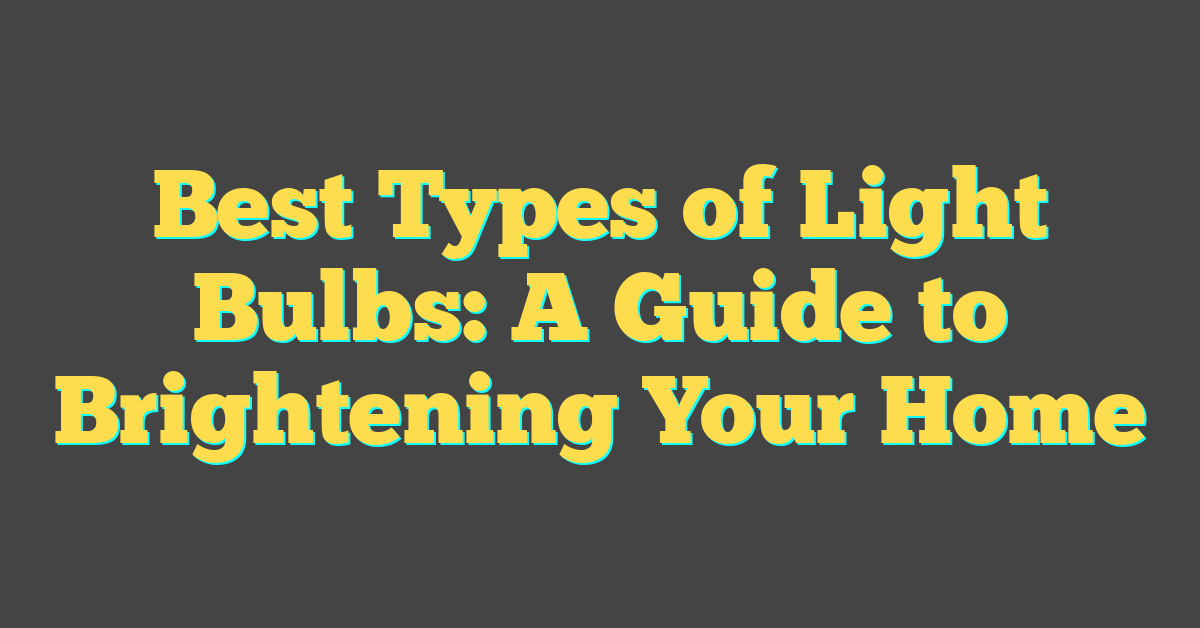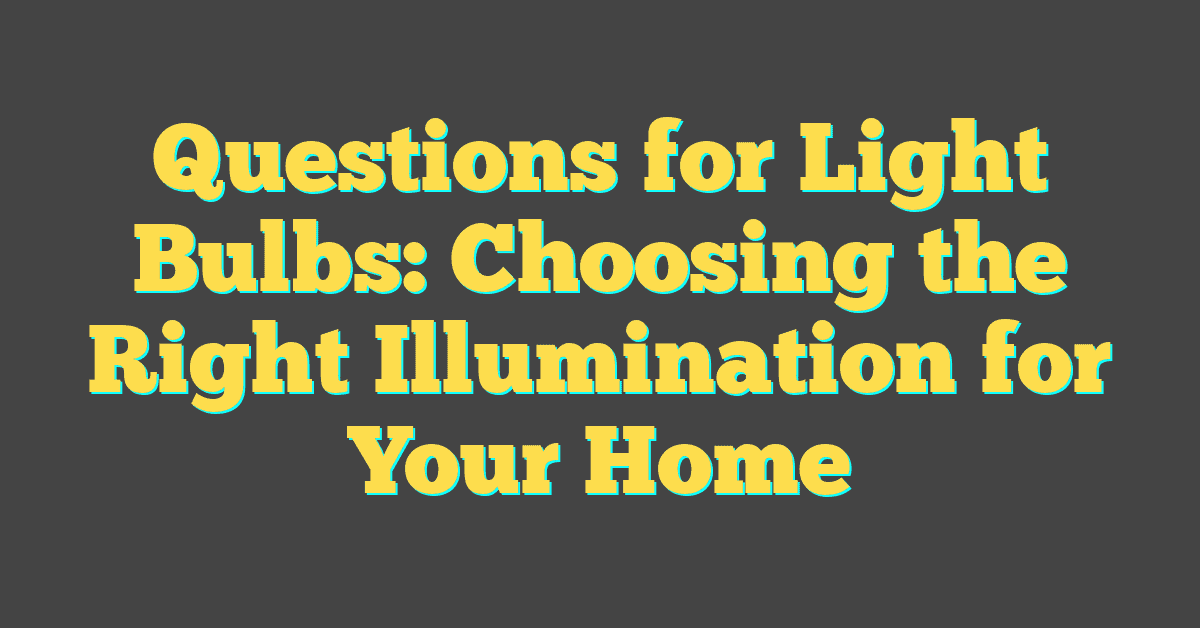Outdoor lighting does more than just illuminate your yard; it can impact which creatures are drawn to your outdoor spaces after dark. Interestingly, the type of light bulb you choose can make a significant difference in the attractiveness of your home to flying insects. Traditional incandescent bulbs are notorious for luring bugs, but advances in lighting technology offer better options that can minimize this effect. Finding the best outdoor light bulbs that don’t attract insects involves understanding how various bulbs work and which features can help deter these tiny, uninvited guests.


As you plan the lighting for your outdoor area, considering the color temperature and bulb type is crucial. A warmer colored LED light, emitting a yellow/orange hue, has been proven to be less appealing to insects compared to the blue light spectrum. Not only does this help keep bugs at bay, but it also creates a cozy ambiance for your outside living areas. Additionally, it’s beneficial to take into account the ecological impact outdoor lighting can have, as excessive or improper lighting can contribute to light pollution, which not only affects human health and sky visibility but also the behavior of wildlife.
Key Takeaways
- Selecting the right outdoor light bulbs is essential for reducing bug attraction.
- Warm LED lights are preferable for a bug-reducing, cozy outdoor environment.
- Considering ecological effects, such as light pollution, is important when planning outdoor lighting.
Understanding Bug Attraction to Light
https://www.youtube.com/watch?v=Pl0icc3XiVI&embed=true
When you switch on a light outside at night, you have probably noticed bugs gather around it. But why does this happen? It’s all about an insect’s natural reaction to light and the type of light you’re using. Let’s explore the science behind this phenomenon.
The Science of Phototaxis
Phototaxis is an insect’s instinctual movement toward or away from light. Bugs exhibiting positive phototaxis are attracted to light sources, which explains why they swarm around your outdoor lamps. Conversely, negative phototaxis is observed in insects that avoid light. This behavior has evolutionary roots, as light has often been a signal for food or heat, influencing the survival of these species.
Wavelengths and Insect Behavior
The light spectrum includes various wavelengths, each perceived as different colors by both humans and insects. Bugs are not just attracted to any light; they’re mostly drawn to short wavelengths like ultraviolet (UV) and blue light, which are invisible to humans. Some lights, specifically those that emit warm-colored LEDs or yellow tones, tend to attract fewer bugs because they emit light at wavelengths outside of the most attractive spectrum for most insects.
To minimize the attraction of insects to your lighting, choose bulbs that emit less light in the UV to blue range of the visible spectrum. This approach will help make your outdoor experiences more pleasant, without the constant buzzing of bugs around your lights.
Types of Bulbs and Insect Attraction
https://www.youtube.com/watch?v=338Zzf2isHQ&embed=true
When selecting outdoor lighting, you have various options that can impact how many insects you attract. The type of light bulb you choose plays a critical role, as different bulbs emit different types of light and heat, which can either lure or repel insects.
LED Bulbs
LED bulbs are notable for their energy efficiency and low heat emission. Unlike traditional bulbs, warm-colored LED bulbs are less attractive to insects, making them an ideal choice for outdoor lighting. According to a study mentioned on ScienceAlert, warm LED bulbs attract the least amount of insects.
Incandescent Bulbs
On the other hand, incandescent bulbs emit more warmth and a broader spectrum of light, which can increase their attractiveness to night-time bugs. They produce white light that includes blue and ultraviolet tones, which are known to attract insects. It is important to note that incandescent bulbs are the biggest culprits in regards to insect attraction.
Halogen Bulbs
Halogen bulbs, while more energy-efficient than incandescent bulbs, still emit a significant amount of UV light and heat. This can make them more attractive to insects compared to some other lighting options. Therefore, they are not the best choice if your aim is to minimize bug attraction.
CFL Bulbs
Finally, CFL (Compact Fluorescent Lamp) bulbs can attract a moderate number of insects due to their UV light emissions. While they are generally better than incandescent and halogen bulbs in terms of attracting fewer insects, they still fall short compared to the bug-repellent capabilities found in certain LED bulbs.
Color Temperature and Its Impact
https://www.youtube.com/watch?v=wPPIxTMsQ2g&embed=true
« Where to Buy Light Bulbs: Your Ultimate Shopping Guide
Lighting EVER LED Rechargeable Headlamp L3200 Review: Top Pick for Hikers? »
When you’re choosing outdoor light bulbs, the color temperature is crucial in determining how attractive your lighting will be to bugs.
Understanding Color Temperature
Color temperature is measured in Kelvin (K), and it describes the color appearance of the light emitted by a bulb. The lower the Kelvin number, the warmer, and more yellow the light. Your warm white bulbs typically have color temperatures around 2,700K to 3,000K. These emit a soft, warm light that is similar to the glow of sunrise or sunset. On the other hand, cool white bulbs range around 3,500K to 4,100K, producing a brighter, more invigorating light. The daylight category, with color temperatures above 5,000K, emits a bluer light resembling midday sunlight.
Warm Versus Cool Lighting
Warm lighting is generally more welcoming and less attractive to bugs. Lights with a yellow color are less visible to many flying insects, including those pesky mosquitoes. This is because insects are more attracted to the blue and green spectrum of light.
Cool lighting, especially bulbs labeled as daylight or cool white, is higher on the Kelvin scale and tends to attract more bugs. Their bluer tint falls within the spectrum that many insects are drawn to, which can lead to an unwelcome swarm around your outdoor light fixtures.
By opting for bulbs with a warm yellow hue, you’re more likely to enjoy a bug-free outdoor environment while maintaining a cozy and inviting atmosphere.
Best Bulb Features to Deter Bugs

When choosing outdoor light bulbs to minimize the attraction of bugs, you’ll want to focus on brightness and the color of the light, as well as the durability and lifespan of the bulb.
Brightness and Efficacy
- Brightness: The brightness of a bulb is measured in lumens. For bug deterrence, it’s not just about how bright the bulb is but the color temperature of the light. A bulb that emits a warm-colored light, especially yellow bug lights, will be less appealing to insects compared to one with cool, blue tones.
- Energy Efficiency: LED light bulbs are known for their energy efficiency. They use less power and can produce a warm amber light that is less attractive to bugs. An LED bulb with high lumens and a lower color temperature (around 2200K to 2700K) strikes a balance between being bright enough for human use and less enticing for insects.
Bulb Longevity and Durability
- Lifespan: LED bulbs generally have a longer lifespan than traditional incandescent bulbs. This means you’ll change them less often, saving time and money in the long run.
- Weather Resistance: Ensure the outdoor bulbs you choose are rated for weather resistance. Look for features like a solid bulb base and robust design that can withstand various weather conditions from rain to snow.
- Durability: Since outdoor bulbs are exposed to more extreme conditions than indoor bulbs, opt for LED bulbs renowned for their durability and longevity. Some LED lanterns or yellow compact fluorescent lights also come in sturdy enclosures that protect them from the elements.
Selecting the right bulb makes your outdoor lighting less attractive to bugs and can result in a more comfortable outdoor space for you and your family.
Designing Outdoor Lighting

Designing your outdoor lighting involves a balance of functionality and aesthetics, ensuring that the lights are bright enough for safety yet warm enough not to attract unwanted bugs. To create a bug-free zone, look for LEDs with cooler color temperatures that are less appealing to them.
Porch and Patio Lights
For your porch and patio, incorporating lantern-style lights can offer a classic feel whilst minimizing insect attraction. Opt for LED bulbs with a color temperature below 3000K; the warmer hues are less likely to draw the attention of night-flying insects than their cooler counterparts. Consider wall-mounted fixtures or overhead options for ample illumination without making your porch a bug magnet.
Garden and Pathway Lighting
Moving out to the garden and pathways, aim for evenly spaced lights that provide a soft glow along walkways, reducing the chances of attracting bugs. Globe lights or low-voltage landscape lights work well here. The key is to use bulbs that emit minimal UV light, as UV is a strong attractant for insects.
String Lights and Decorative Options
Decorative lighting like outdoor string lights can add charm to your space. When selecting string lights or rope lights, pay attention to bulb type: yellow bug lights or warm LED lights can be both inviting and less attractive to insects. Hanging them higher can help, as many bugs tend to fly at lower levels. With lantern lights, you can adorn trees or eaves, bringing a delightful yet practical ambiance to your outdoor soirées.
Ecological Implications of Light Pollution
https://www.youtube.com/watch?v=lit0RgbJ-6Q&embed=true
Your understanding of light pollution’s effect on the environment is critical. It not only alters the natural behavior of nocturnal insects but also cascades through the food chain, affecting predators and their prey.
Effects on Insect Populations
Studies, such as those documented by ecologists, suggest that light pollution significantly alters the behavior and survival of nocturnal insects. For example, using amber-filtered bulbs instead of white light can lead to 60% fewer insects being attracted to the lights. This may seem beneficial to you, but it affects the entire food web. For many species, street and outdoor lighting are equivalents to a fatal attraction, leading insects to exhaust themselves or become easy prey.
Impact on Predator-Prey Dynamics
Journal articles often detail the ripple effects that reduced insect populations have on predators. The imbalance created when there are fewer bugs to eat can stress the environment, as well as the species reliant on these insects for food. Predators that depend on these insects must adapt or face starvation. These effects extend beyond just one predator-prey interaction and can, in turn, impact the variety and abundance of other species in the ecosystem.
Alternative Bug Control Methods

When considering how to minimize bugs around your outdoor lighting, you might want to look into alternative bug control strategies. These methods can complement your selection of outdoor lights that don’t attract bugs, helping to create a more pleasant outdoor experience.
Bug Zappers and Their Efficiency
Bug zappers can be an option to control the bug population in your outdoor space. These devices use light to lure insects and then eliminate them using electricity. It’s important to note that bug zappers might not distinguish between pests and beneficial insects, reducing the population of helpful predators. When using bug zappers, you’re trading specificity for convenience—while they can reduce the number of flying insects, they might also impact local ecosystems.
Natural Methods and Predator Encouragement
Natural methods for bug control involve creating a welcoming environment for natural predators of insects. Birds, bats, and even some species of insects can serve as natural pest control. You can encourage these helpful predators to visit your yard by installing birdhouses, bat boxes, and maintaining gardens that attract beneficial insects that prey on the pests you want to deter. This approach to bug management not only contributes to maintaining a balanced ecosystem but also reduces the need for chemical interventions.
Installation and Maintenance Tips

Choosing the right outdoor LED bulbs can significantly reduce the presence of bugs, but proper installation and regular maintenance are key to ensuring these lights function effectively and last longer.
Easy Installation Techniques
Before installing LED lights in your outdoor space, ensure you have the correct fixtures that are compatible with LED bulbs. Some LED lamps may require specific base types or enclosures:
- Verify bulb base type (E26, E12, etc.) to match your fixture
- Choose LED bulbs rated for outdoor use to withstand weather elements
Tip: Outdoor LED bulbs with a lower color temperature (<3000K) typically attract fewer bugs.
Routine Maintenance and Cleaning
Regular maintenance of LED lamps helps to preserve their bug-repelling qualities and keep them shining bright:
- Turn off the power to the fixture before cleaning.
- Gently wipe the LED bulbs with a dry, soft cloth to remove dust and debris.
- Inspect the fixture seals to prevent water damage and insect nests.
- Every few months, clean the surrounding fixture area to remove any insects or cobwebs.
Remember: Avoid using harsh chemicals or rough materials that can damage the LED’s surface.
Frequently Asked Questions

Navigating the world of outdoor lighting can be tricky, especially when considering how to minimize the attraction of insects. In this section, we’ll address common concerns and provide targeted guidance to keep your outdoor spaces more peaceful and less appealing to a variety of insects.
Choosing the Right Bulb for Your Space
Bulbs that emit certain types of light are less appealing to bugs. For instance, LED light bulbs, especially those with a warm color temperature, are generally less attractive to insects such as moths, flies, beetles, and mosquitoes. On the other hand, traditional incandescent bulbs tend to attract more insects. Opting for yellow-tinted sodium or halogen bulbs can be a good choice as well because many flying insects are less drawn to yellow wavelengths.
Handling Broken Bulbs
In the event that a bulb breaks, safety should be your primary concern. If you’re dealing with compact fluorescent lamps (CFLs), you’ll need to take extra precautions due to the small amount of mercury they contain. Turn off the power to the fixture before clean-up, ventilate the area, and use stiff paper to gather the debris. Avoid using a vacuum until you have removed all visible materials, as vacuums can spread mercury-containing dust.
Upgrading Your Outdoor Lighting System
Upgrading to the newest technology can be beneficial. While LED light bulbs might have a higher upfront cost, they last longer and are more energy-efficient than traditional incandescent lamps. Plus, LEDs emit less heat, reducing the warmth that attracts insects such as ants, earwigs, bees, and stink bugs. For a bug-resistant ambiance, consider red bulbs as an option; they’re among the least attractive to bugs and can create a cozy atmosphere for your outdoor space.
Make your evenings outdoors more enjoyable by choosing the right lighting and handling it with care. This way, you can create a welcoming environment for yourself and your guests without the buzzing and biting of unwelcome insect visitors.
Conclusion

When selecting outdoor light bulbs to minimize the presence of flying insects like stinkbugs, remember that the type of light emitted plays a significant role. Insects are generally attracted to lights due to a behavior called phototaxis, which draws them to brightness. Traditional bulbs with glowing filaments might be appealing to them, but there are better options.
LED lights emitting a warm hue, particularly those that fall within the yellow/orange part of the electromagnetic spectrum, are the least attractive to bugs. They produce less infrared and visible light that bugs can see, making them a superior choice for your outdoor spaces.
- Consider LEDs that mimic the soft glow of the moon rather than those that imitate daylight.
- Opt for bulbs with lower temperature colors – the warmer, the better.
- Avoid bulbs with high-intensity discharge (HID) that can emit more blue light, which is a bug magnet.
Remember to replace your exterior lighting with options designed to be less enticing to nocturnal insects. Not only will you appreciate a bug-free porch, but you’ll also enjoy the energy efficiency and longevity of your new outdoor light bulbs. Happy and peaceful evenings await on your insect-reduced patio!




